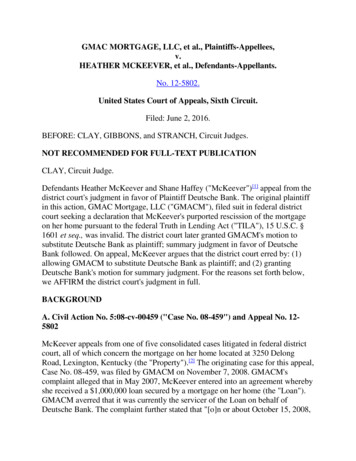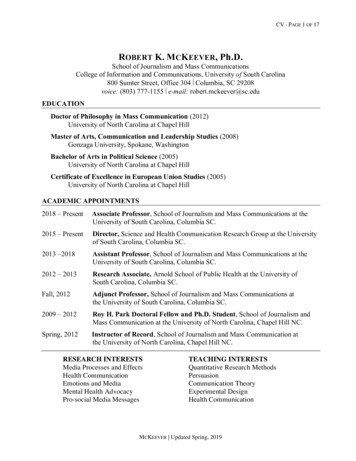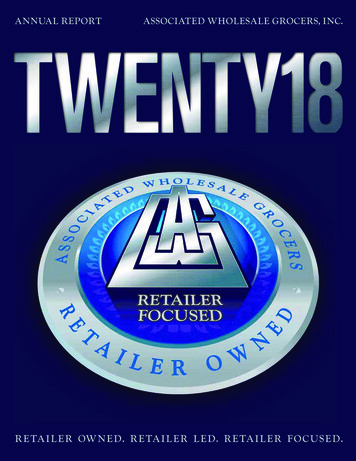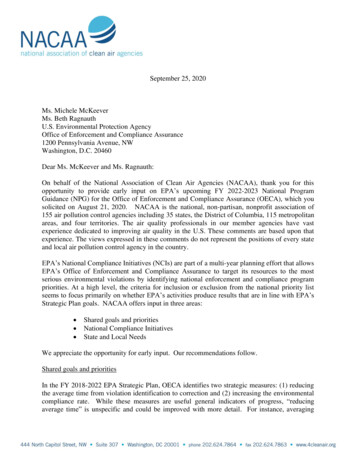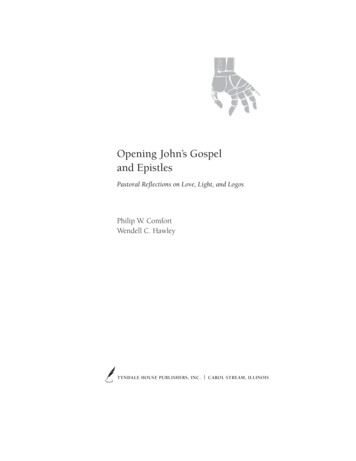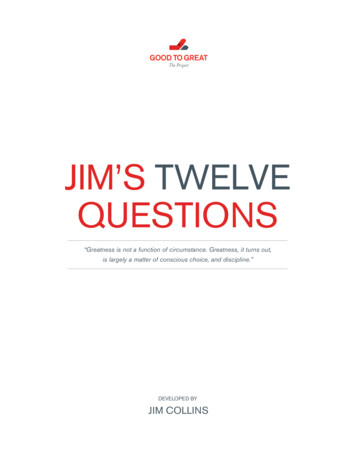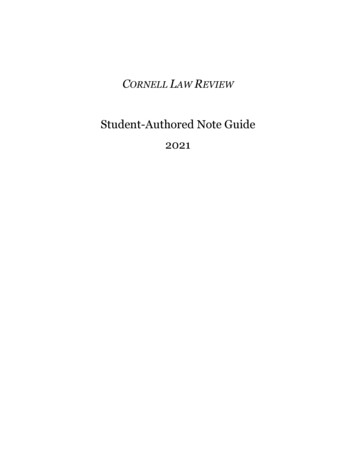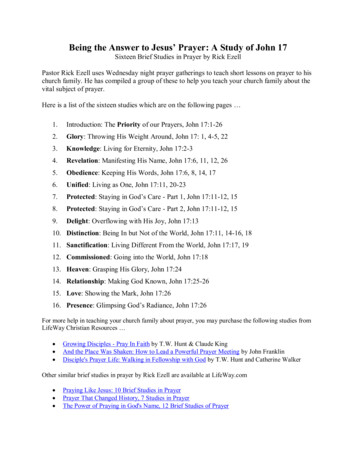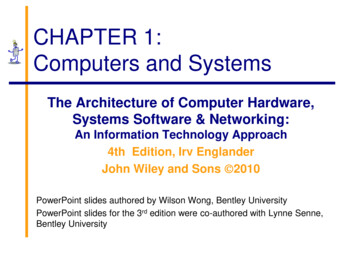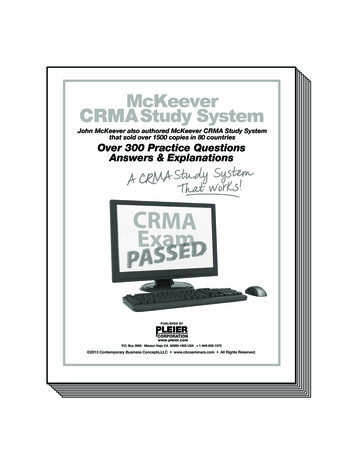
Transcription
John McKeever also authored McKeever CRMA Study Systemthat sold over 1500 copies in 80 countries 2013 Contemporary Business Concepts,LLC www.cbcseminars.com All Rights Reserved.
McKeever CRMA Study SystemCourse OverviewCourse OverviewThank you for using the McKeever CRMA Study System as a tool to helpyou pass The IIA CRMA Exam.Passing the exam portion of the CRMA exam involves 2 parts – 1) passingPart 1 of the CIA Exam and 2) passing the CRMA Exam.The actual CRMA Exam questions are confidential. As a result, the materialand practice questions presented are representative of the body ofknowledge tested by the CRMA Exam. They are not actual questions fromcurrent or past CRMA Exams. The material has been developed andcompiled to the best of the author’s knowledge and from applying CRMAprinciples as a Risk Management Practitioner.The McKeever CRMA Study System will help you prepare for the CRMAExam as follows:1) describes the many areas covered by the CRMA Exam2) presents over 300 practice questions similar to what you will see on theCRMA Exam3) makes you comfortable with complexities and approaches required tochoose the BEST answer4) provides you with guidance for correct answers and feedback aboutincorrect answers5) helps you identify areas on the CRMA Exam that will require youradditional study timeThe IIA web site lists a variety of study material and references to use inpassing Part 1 of the CIA Exam. The IIA web site also contains a listing ofreference to use for CRMA Exam.The McKeever CRMA Study System covers the CRMA Exam in-depth.The wording of multiple-choice questions can often be a greater challengethan the actual material being tested. Therefore, throughout this workbookthere will be opportunities to understand both the technical material thatmay appear on the CRMA Exam as well as how to clarify the wording usedin questions. 2013 Contemporary Business Concepts, LLC, Danbury Connecticut USA1
McKeever CRMA Study SystemCourse OverviewThis material contains extensive discussion of the technical topics thatmay appear on the CRMA Exam. In addition, there are sample questionsrelated to the topics. These modules contain the correct answer to eachquestion along with an explanation, which examines the wording of thequestion. There are a substantial number of advanced questions. Thesequestions are more typical of what will appear on the CRMA Exam. Theseadvanced questions are presented in two parts. The first part provides thequestions only. The second part is more comprehensive with thequestions and their answers highlighted, along with an explanation of thecorrect answer. Periodically throughout the workbook, there will beextractions from these advanced questions to examine their wordingcontent, keyword traps, and the technical content of the questions.Although the discussions in each domain contain substantial material, it isadvised that the participants review the advanced questions. Reviewingpractice questions and becoming familiar with the wording of multiplechoice questions can be a great aid in the preparation for a multiple-choiceformat test.There are also additional references available at www.pleier.com includingthe McKeever CCSA Study system, Achieving Audit Excellence, RiskManagement Risk Assessment, Exceeding Expectations for InternalAuditors, and Transition: Internal Audit to Internal Assurance.Although review courses by themselves including the McKeever CRMAStudy System are generally not sufficient to ensure exam success thisstudy system will certainly provide you with an approach to significantlyimprove your chances of passing. The IIA web site offers a variety ofadditional references for further study that is also listed the ReferenceModule of this workbook.Please feel free to contact me at johncbc@att.net.Wishing You the Best of Success on the CCSA Exam,John J. McKeeverCRMA, CCSA, CFE, CQA, CBM2 2013 Contemporary Business Concepts, LLC, Danbury Connecticut USA
McKeever CRMA Study SystemCourse OverviewMcKeever CRMA Study SystemAuthorJohn J. McKeeverCRMA, CCSA, CQA, CFE, CPC, CBMJohn McKeever, President & COO of Contemporary Business Concepts, LLC., isprobably best known as the author of the McKeever CCSA Study System andMcKeever CCSA Practice Test used by 100s to pass the IIA CCSA Exam.John frequently speaks at public seminars; professional associations; state andfederal agencies; and corporations. His work includes developing and deliveringrisk and control management programs specifically focused for the needs ofSenior Executives, Boards of Directors, and Audit Committees. .John has served as Operations Manager, Consultant, Instructor, and member ofATT&T audit staff. During 15 years in the audit department at AT&T, heconducted and led a wide range of audits and consulting projects. Theseincluded audits and projects of finance, operations, and information technology.While in private practice; at the AT&T School of Business; and at The Institute ofInternal Auditors John has developed and delivered a number of programs whichinclude, Consulting: A Value Added Service The Tools and Techniques ThatMake It Work, COSO The Steps To Success, Help Your Client Succeed withControl Self-Assessment, and The McKeever CCSA Study System. For hisachievements as a seminar leader, The Institute of Internal Auditors has awardedJohn the designation of Distinguished Adjunct Faculty Member.In addition John has authored numerous research papers that have addressedthe concepts of process improvement in business, employee empowerment, andthe management of effective teams. Using these tools, he has guided andencouraged thousands of domestic and international professionals to movetoward process and business improvements.John has degrees in Business Administration and Management fromNortheastern University, a Master of Science Degree in Management fromStevens Institute of Technology, and a graduate level Certificate in Total QualityManagement from the University of Phoenix. He is a Certified Quality Auditor, aCertified Fraud Examiner, a Certified Business Manager, a Certified ProfessionalConsultant, and holds a Certification in Risk Management Assurance. In addition,John holds both a Control Self-Assessment Qualification and a Certification inControl Self-Assessment.He is a member of the American Society for Quality, The Institute of InternalAuditors, The Association of Business Professionals in Business Management,and the Association of Certified Fraud Examiners. 2013 Contemporary Business Concepts, LLC, Danbury Connecticut USA3
McKeever CRMA Study SystemCourse OverviewIndexCourse OverviewDomain I: Organizational governance related to riskmanagementDomain II: Principles of risk management processesDomain III: Assurance role of the Internal Auditor (IA)Domain IV: Consulting role of the Internal Auditor (IA)Suggested Additional ReferencesAppendicesApplication QuestionsApplication Questions, Answers & Explanations4 2013 Contemporary Business Concepts, LLC, Danbury Connecticut USA
McKeever CRMA Study SystemCourse OverviewOverviewCRMA and the McKeever CRMA StudySystemCertificate in Risk Management Assurance (CRMA)The Certificate in Risk Management Assurance (CCSA ) is a specialtycertification program offered by The Institute of Internal Auditors (The IIA).It is designed for internal auditors who develop specialized riskmanagement assurance skills. Gaining the required knowledge of areassuch as risk and control exposes internal auditors to the concepts that arevital in more effectively using risk management principles to help clientsachieve their objectives.Internal auditors at any experience level, in almost all positions, will benefitfrom this certification program.Visit the IIA’s web site www.theiia.org. There you will find a number ofvaluable resources listed to help you pass both Part 1 of the CIA Exam andthe CRMA Exam.Be certain to review The IIA’s web site resources in detail as theinformation listed there tells what you need to know about therequirements for becoming a CRMA including professional experience andCRMA Exam overview.The McKeever CRMA Study System builds on the information available atThe IIA web site. It does not replace the need to review the information onthat web site.The McKeever CRMA Study System provides a studying methodology andtechniques to help you successfully pass the CRMA Exam. In addition, youshould find that the McKeever CRMA Study System is an excellent,practical, application reference source for applying risk managementprinciples in practice. 2013 Contemporary Business Concepts, LLC, Danbury Connecticut USA5
McKeever CRMA Study SystemCourse OverviewMcKeever CRMA Study SystemThe McKeever CRMA Study System provides the following to help yousuccessfully pass the CRMA Exam:1) outlines how to study for the CRMA Exam2) explains, in detail, the information you need about the contents of eachdomain on the CRMA Exam and demonstrates techniques to address multiplechoice question3) provides over 300 sample questions, with answers and explanations, similar tothe ones you will see on the CRMA Exam - not the actual questions that mayappear on the CRMA Exam since the actual exam questions are confidential4) provides an extremely valuable resource for both self-study mode and grouptraining5) helps you identify areas where you need additional study prior to the exam6) provides a guide for resources to use in preparing to pass the examHow to Study for the CRMA ExamThere is no standard way to study for the CRMA Exam as each person has anindividual study style. However, the McKeever CRMA Study System doesprovide proven test-taking techniques.The McKeever CRMA Study System:Study the modules covering CRM Domains in any sequenceLimit study to a comfortable time in both group study and self-studyDo not try to cover everything in one sessionFor group study we recommend no less than 16 hours of team study. This timeshould include reviews of both the content in the modules and review of theSample Questions with Answers and Explanations.While studying the material you will see a STOP sign with a sample question. Tryto determine the “best answer”. Then look at the answer and explanation in theApplication Questions, Answers & Explanation module.6 2013 Contemporary Business Concepts, LLC, Danbury Connecticut USA
McKeever CRMA Study SystemOrganizational governance related to risk managementReview the Application Questions module after studying the Domain modules.DOMAIN I:ORGANIZATIONALGOVERNANCERELATED TO RISKMANAGEMENTEXTRACT 2013 Contemporary Business Concepts, LLC, Danbury Connecticut USA7
McKeever CRMA Study SystemOrganizational governance related to risk managementDomain I: Organizations andOrganizational CultureThe objective of this module is to better prepare the participant to pass theCertification in Risk Management Assurance Exam by discussing andanalyzing the technical dimensions of this domain while discussingtechniques to best manage multiple-choice questions.Included are discussions of the skill requirements of a CRMA to:A. Assess risk management processes in the context of alignment withstrategic imperatives1) Objectives of risk management processes2) Organization's risk culture3) Risk capacity, appetite, and tolerance of organizationB. Assess the processes related to the elements of the internalenvironment in which organizations seek to manage risks and achieveobjectives1)2)3)4)5)6)Integrity, ethical values, and other soft controlsRole, authority, responsibility, etc., for risk managementManagement's philosophy and operating styleLegal / Organizational structureDocumentation of governance-related decision-makingCapabilities, in terms of people and other resources (e.g., capital, time,processes, systems, and technologies)7) Management of third party business relationships8) Needs and expectations of key internal stakeholders9) Internal policiesC. Assess the processes related to the elements of the externalenvironment in which organizations seek to manage risks and achieveobjectives1) Key external factors (drivers and trends) that may impact the objectives ofthe organization2) Needs and expectations of key external stakeholders (e.g., involved,interested, influenced)Source: The IIA International web site8 2013 Contemporary Business Concepts, LLC, Danbury Connecticut USA
McKeever CRMA Study SystemOrganizational governance related to risk managementOrganizations and Organizational CultureIn order for organizations to establish a risk culture, it is first necessary tounderstand an organization as an entity. By simple definition, organizations aresocial entities that are goal-directed deliberately structured activities systems withpermeable boundaries. More specifically, organizations as social entities arepeople or groups of people who function together to perform the tasks andfunctions of the organization so that the organization may reach its objectives.Deliberately structured organizations objectives and goals are typicallysubdivided into subsets of activities. Hence, a different perspective of goals andobjectives become apparent at the different levels within an organization.Although, with these different perspectives, these subdivided sets of activitiesshould work toward the overall organization objectives and goals.With this in mind, the deliberate structure of an organization should facilitate andcoordinate the efforts of all of the subdivided sets and move uniformly toward oneefficient and effective effort.All organizations have permeable boundaries that at least should separate themfrom other organizations. This is called differentiation. This distinction definesindividual organizations, functions, and purposes. In terms of competition,differentiation of purpose, product, or service will distinguish one organizationfrom another. From the competitive perspective this differentiation is what willcause a customer or client to choose one company or organization over another.Some reasons for these customer/client differentiated choices could be price,location, customer service, quality, likeability of the company, and compatibilitywith customer needs and wants.Organizations probably had more defined and distinctive boundaries in the pastHowever, in these more contemporary times the boundaries of organizationshave become and must be more permeable or flexible. In order to survive it isnow necessary that organizations share with each other information, cooperate,and collaborate. The sharing of technology, ideas, and components as well asinternational trade are just some examples of the necessity for more permeableboundaries of today’s organizations.Further organizations can be subdivided into two distinct classes that directlyrelate to the organizations focus and ability to address their risk and hence theirsuccess. These classes of internal risk and external risk will be discussed laterin detail. Internal risks include training; capabilities of staff and employees; thelack of physical controls such as locks, cameras; and passwords to name a few.Internal risks can be understood and fixed. Generally, there is or can be somecontrol over internal risks 2013 Contemporary Business Concepts, LLC, Danbury Connecticut USA9
McKeever CRMA Study SystemOrganizational governance related to risk managementExternal risks on the other hand are the elements that have an impact on theorganization but that the organization has little or no control over. Consequently,the organization, although having little or no control over the advent of theseexternal risks, must plan for and manage these external risks. External risks caninclude the environment, weather, interest rates, the economy, internationalrelations, international suppliers, exchange rates, politics, and government rulesand regulations.The two subcategories of organizations that relate to both the internal andexternal risks are an open organization system and a closed organizationsystem. A closed system does not depend on the environment in which itoperates. The management of a closed system would be relatively simple tounderstand and manage; with no external influences to worry about, the closedorganization system would most likely be stable and predictable. A closedorganization would be totally autonomous, enclosed and sealed off from theoutside world of external influences. Although possible, it is unlikely that acompletely closed organization system by definition could exist in today’sbusiness environment.Answer the Following Question.8. The Senior Vice President of Operations reports directly to the Chairman andPresident of Products Inc. This is a family-owned company which has grownsubstantially over the past few years. Now named Products International itsgrowth can be attributed mostly to the purchase of three international companies.These newly-purchased companies provide similar products as the parentcompany and were also looking to expand to international markets. As all ofthese companies provide generally the same products which type of operatingenvironment is Products International?a.b.c.d.product differentiation environmentopenconglomerateclosedSee Application Questions, Answers & Explanations module for answer10 2013 Contemporary Business Concepts, LLC, Danbury Connecticut USA
McKeever CRMA Study SystemOrganizational governance related to risk managementCategories:An open system must interact with the environment. This is a more likelysituation in today’s environment. Open systems can be very complex and mustrequire innovative and proactive management. Open systems have to find andobtain needed resources, interpret and act on environmental changes (externalrisks), dispose of outputs, control and coordinate internal and external activities,and manage environmental changes. Sometimes working closely withcompetitors and international markets their complexity increases. Remember ascomplexity increases so does risk.Organizational structure definitions are fine to establish a framework fororganizational culture but it is people, humans that make an organization functionas it is intended. It is these people that establish the culture for such things asethics, attitude, moral, risk management, and the establishment andimplementation of adequate controls and move the organization toward itsobjectives most efficiently and effectively.Connecting the tone:Looking from the top-level of an organization downward, upper management isresponsible for the entire organization. Upper management must establishobjectives and goals, develop strategy, interpret the external environment, andadjust for the influences that the external environment imposes on theachievement of objectives. Further upper management must decided upon andinfluence the organization design and structure. In more detail, uppermanagement must influence the entire organization toward compliance with lawsand regulations, facilitate the accomplishment of goals and objectives, establishthe reliability or information to internal and external stakeholders, manage theefficient and effective use of resources, and solidify the safeguarding of assets.Probably most importantly is the tone that is established and emulated by topmanagement. The words, speeches, posters, and newsletters are all fine butwithout a sincere tone of support and belief from top management, all of thewords, speeches, posters, and newsletters are just that and will have little impacton the intended direction of the organization.Next from the top down are middle managers. Middle managers are or shouldbe concerned with the functioning of individual departments such as accountspayable, marketing, operations, and human resources to name a few. Thesemiddle managers must interrelate the functioning of their respective departmentsto the overall goals and objectives of the overall organization. These middlemanagers must design and implement effective interrelations of politics,technology, cooperation, along with risk and control management amonginterfacing departments. 2013 Contemporary Business Concepts, LLC, Danbury Connecticut USA11
McKeever CRMA Study SystemOrganizational governance related to risk managementWhy the Concern with Third Party Relations?Some Risks Associated withThird-Party RelationshipsStrategic risk. Strategic risk is the risk to earnings or capital arising fromadverse business decisions or improper implementation of those decisions.Strategic risk can exist when there is an aggressive effort to remain competitiveor boost earnings, and or use third-party relationships without fully performingdue diligence reviews or implementing the appropriate risk managementinfrastructure to oversee the third party relationship. Strategic risk also arises ifmanagement does not possess adequate expertise and experience to properlyoversee the activities of the third party.Reputation risk. Reputation risk is the risk to earnings or capital arising fromnegative public opinion. Of all risks, this can probably be the most harmful bothin the long and short terms. Third-party relationships that do not meet theexpectations of customers or clients expose the company to reputation risk. Poorservice, disruption of service, inappropriate sales recommendations, andviolations of consumer law allowed by third party relationships can result inlitigation, loss of business or both.This is particularly true when the third party's employees interact directly withcustomers or clients and employ situations or actions are not consistent with thepolicies and standards of the parent company. In addition, publicity aboutadverse events surrounding the third parties may increase (reputational risk).Compliance risk. Compliance risk is the risk to earnings or capital arising fromviolations of laws, rules, or regulations, or from nonconformance with internalpolicies and procedures or ethical standards. This risk exists when products,services, or systems associated with the third-party relationship are not properlyreviewed for compliance, or when the third party's operations are not consistentwith law, ethical standards, and policies and procedures of the parent company.Transaction risk. Transaction risk is the risk to earnings or capital arising fromproblems with service or product delivery. Transaction risk is evident in eachproduct or service offered by the third party on behalf of the parent company.Transaction risk can increase when the products, services, delivery channels,and processes that are designed or offered by a third party do not fit with theparent companies, customer demands, or strategic objectives. A third party'sinability to deliver, on behalf of the parent company, products and services,whether arising from fraud, error, inadequate capacity, or technology failure,exposes the parent company to transaction risk.12 2013 Contemporary Business Concepts, LLC, Danbury Connecticut USA
McKeever CRMA Study SystemOrganizational governance related to risk managementSummary:Risk and control management and the achievement of overallobjectives is the responsibility of everyone. However, in orderfor this to be successful upper management and the Board ofDirectors must recognize and manage the internal and externalrisk as well establish a risk appetite (the amount of risk that iswilling to be accepted in order to achieve objectives). Further, itis the responsibility of the Board of Directors and managementto effectively communicate and monitor this risk philosophy andculture to everyone. 2013 Contemporary Business Concepts, LLC, Danbury Connecticut USA13
McKeever CRMA Study SystemOrganizational governance related to risk managementOrganizational governance related to risk management1.3 when upper management is establishing acultural philosophy they must understand andadjust for:1. internal and external politics2. internal controls3. feedbackAnswer 4 is the correct answer. The otheranswers are nice common words but do notapply to this question. The only answer thatmay even warrant some consideration wouldbe answer 1. However, answer 1 is narrowonly addressing the politics. Politics can be arisk but only one risk. Answer 4 impliesmultiple internal risks and external risks. It ismuch better to understand the implications ofas many internal and external risks as possiblewhen developing cultural philosophy.4. internal and external risk14 2013 Contemporary Business Concepts, LLC, Danbury Connecticut USA
McKeever CRMA Study SystemPrinciples of risk management processesDOMAIN II:PRINCIPLES OF RISKMANAGEMENTPROCESSESEXTRACT 2013 Contemporary Business Concepts, LLC, Danbury Connecticut USA15
McKeever CRMA Study SystemPrinciples of risk management processesDomain II: Principles of risk management processesThe objective of this module is to better prepare the participant to pass theCertification in Risk Management Assurance Exam by discussing andanalyzing the technical dimensions of this domain while discussingtechniques to best manage multiple-choice questions.Included are discussions of the skill requirements of a CRMA to:A. Benchmark risk management processes using authoritative guidanceB. Evaluate risk management processes related to:1. Setting objectives at all levels to achieve strategic initiatives2. Identifying risks3. Risk analysis and evaluation including correlation, interdependencies, and prioritization4. Risk response (e.g., avoid, transfer, mitigate, accept), includingcost/benefit analysis5. Developing and implementing risk mitigation plans6. Monitoring risk mitigation plans and emerging risks7. Reporting risk management processes and risks, including riskmitigation plans and emerging risks8. Periodic review of risk management processes to aid in continuousimprovementSource: The IIA International web site16 2013 Contemporary Business Concepts, LLC, Danbury Connecticut USA
McKeever CRMA Study SystemPrinciples of risk management processesPrinciples of Risk Management ProcessesManagers put assets at risk to achieve objectives.Establishing ObjectivesEstablishing objectives should be the first step in any business process.Establishing objectives has to be the first step whenever performing a review ofbusiness risks or a risk or control analysis. If the objectives are overlooked, theefforts will be wasted.Back to basics: These are the three basic elements of business objectives, risks,and controls which should be addressed in that order. The very first element andthe foundation necessary to be able to address the implementation andadequacy of risk management is an objective. Any process, physical task, orhuman effort must have an objective, a clear focus of what is trying to beaccomplished.Some of the general terms associated with the establishment of objectives, inorder of decreasing detail are the mission statement, the objectives, and goals.Generally, the amount of detail to accomplish the objectives increases with thedefinition of goals. However, no matter if the mission, objectives, or goals arebeing discussed it is necessary that a clear focus of what it trying to beaccomplished be kept in mind.Objectives Must Be Specified First, if objectives are not specified first risk will become overwhelming risk may not be controllable efforts and resources will be wasted 2013 Contemporary Business Concepts, LLC, Danbury Connecticut USA17
McKeever CRMA Study SystemPrinciples of risk management processesBelow are the criteria, most often associated with the definition of goals.However, they can be utilized for establishing adequate objectives as well:Specific: means that a definitive outline of what is to be accomplished beidentified. The more specifics that are identified the more likely theobjectives will be accomplished effectively and efficiently. Conversely, theless specifics that are identified the less likely the objectives will beaccomplishes as intended. With fewer specifics, humans will interpret adirection, which may not be in concert with the overall objectives. Hence,inefficiencies will prevail.Measurable: the action to accomplish objectives is subject totechnological and human intervention. Therefore, it is important that ameasurable mechanism be put in place to monitor these actions to insurethat the intended objectives are being accomplished. As with anymonitoring control the monitoring control should not only include aphysical monitoring mechanism but as well an action to adjust deviationsbeyond accepted limits. For extensive objectives, (those which may takean extensive time to complete) benchmark / status measurements areappropriate. This means that periodic measurements at predeterminedtimes be established. These benchmarks / status measurements will helpto guide minor adjustments as they are recognized as opposed to waitinguntil major adjustments are required.Additional comments about benchmarking: benchmarking is themeasuring or comparing of an entity, process, or objective againstanother real or perceived entity, process, or objective. Benchmarkingmeasures progress among or between these relationships. Benchmarkingcan help establish priorities, targets, and the need for adjustments in theprocess.Some uses of benchmarking:18 develop performance measures develop comparisons of performance relative to goods and services access ideas from proven practices develop best practices maintain a competitive advantage 2013 Contemporary Business Concepts, LLC, Danbury Connecticut USA
McKeever CRMA Study SystemPrinciples of risk management processes 2013 Contemporary Business Concepts, LLC, Danbury Connecticut USA19
McKeever CRMA Study SystemPrinciples of risk management processesRisk TermsRisk is a concept. It is a measure of uncertainty (probabilities). In businessprocesses the uncertainty involves the achievement or the barriers to achieveorganizational objectives. Risk may have positive or negative consequences.Generally, positive consequences are known as opportu
you pass The IIA CRMA Exam. Passing the exam portion of the CRMA exam involves 2 parts - 1) passing Part 1 of the CIA Exam and 2) passing the CRMA Exam. . CRMA, CCSA, CQA, CFE, CPC, CBM John McKeever, President & COO of Contemporary Business Concepts, LLC., is probably best known as the author of the McKeever CCSA Study System and

